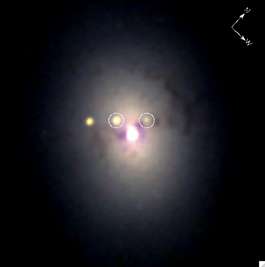Twin Star Explosions Fascinate Astronomers

Scientists using NASA's Swift satellite stumbled upon a rare sight, two supernovas side by side in one galaxy. Large galaxies typically play host to three supernovas per century.
Galaxy NGC 1316 has had two supernovas in less than five months, and a total of four supernova in 26 years, as far back as the records go. This makes NGC 1316 the most prodigious known producer of supernovas.
The first supernova, still visible on the "right" in the image, was detected on June 19, 2006, and was named SN 2006dd. The second supernova, on the immediate "left" in the image, was detected on November 5 and has been named SN 2006mr. (The central bright spot is the galaxy core, and the bright object to the far left, like an earring, is a foreground star.)
NGC 1316, a massive elliptical galaxy about 80 million light years way, has recently merged with a spiral galaxy. Mergers do indeed spawn supernovas by forcing the creation of new, massive stars, which quickly die and explode. Yet all four supernovas in NGC 1316 appear to be Type Ia, a variety previously not associated with galaxy mergers and massive star formation.
Scientists are intrigued and are investigating whether the high supernova rate is a coincidence or a result of the merger.
Swift was launched on this date, November 20, in 2004.
Source: Penn State





















